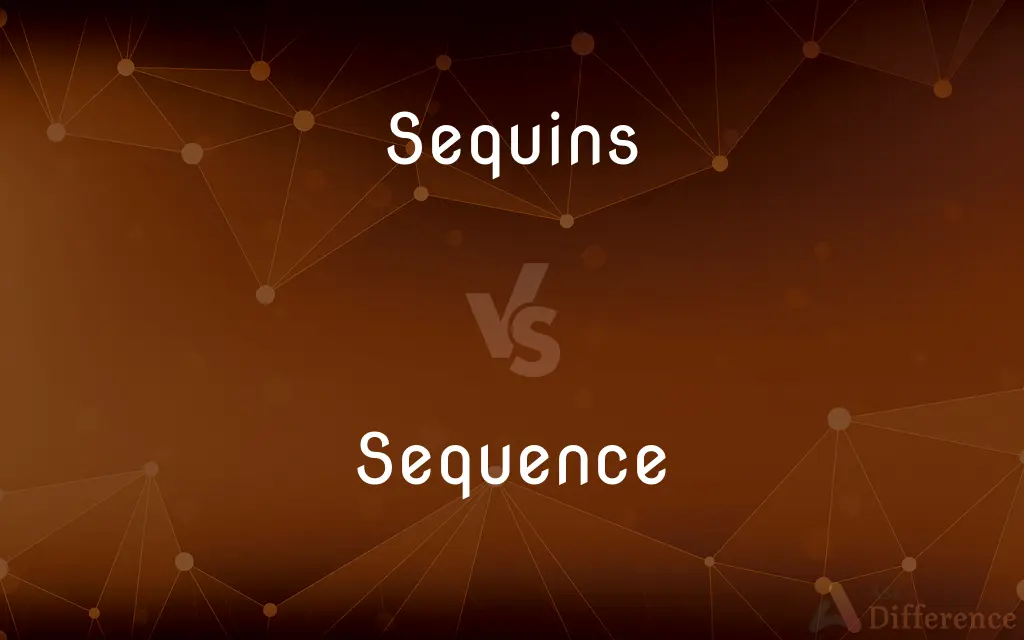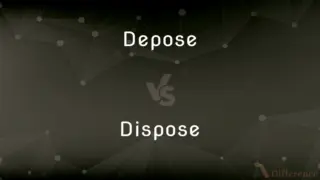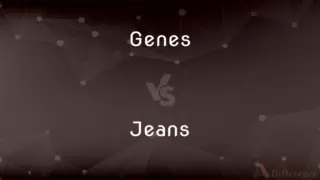Sequins vs. Sequence — What's the Difference?
Edited by Tayyaba Rehman — By Maham Liaqat — Updated on April 26, 2024
Sequins are decorative, shiny discs sewn onto fabric for embellishment, while sequence refers to a specific order in which events, items, or actions follow each other.

Difference Between Sequins and Sequence
Table of Contents
ADVERTISEMENT
Key Differences
Sequins are small, often shiny elements used to add sparkle and visual interest to clothing and accessories, drawing attention with their reflective properties. On the other hand, a sequence is an arrangement where one thing follows another in a specific, logical order, crucial in contexts like storytelling, processes, or mathematical series.
Typically made from plastic or metal, sequins can be various shapes and colors, enhancing the aesthetic appeal of garments and decorations. Whereas, understanding a sequence is essential for organizing thoughts, data, or tasks efficiently, impacting how information is processed and understood.
In fashion, sequins are a popular choice for festive and glamorous outfits, contributing to a garment's texture and dynamics through their movement and interaction with light. Conversely, sequence applies to abstract concepts and practical applications, such as sequences in programming, events in history, or steps in a recipe.
The application of sequins is a creative decision in design, often associated with celebrations and high-energy events, suggesting vibrancy and excitement. In contrast, establishing a sequence can be a critical cognitive function, supporting pattern recognition, prediction, and logical reasoning.
While sequins primarily serve a decorative function, adding visual interest and flair, sequences structure elements and actions, ensuring coherence and facilitating understanding and effectiveness in various disciplines.
ADVERTISEMENT
Comparison Chart
Definition
Decorative discs used for embellishment.
An ordered list of items or events.
Material/Form
Made of plastic or metal, various shapes and sizes.
Conceptual, can relate to abstract or physical items.
Use
Fashion, decoration.
Organizing, logical arrangement, programming.
Purpose
To enhance aesthetic appeal and attract attention.
To establish order and improve understanding.
Impact on Perception
Adds sparkle and visual interest.
Structures information or processes.
Compare with Definitions
Sequins
Can be various colors and shapes, enhancing their visual appeal.
The costume featured multi-colored sequins for a dazzling effect.
Sequence
Essential in mathematical and programming contexts.
He wrote a function to calculate the sum of a geometric sequence.
Sequins
Small, shiny discs used for decoration on clothing.
Her dress was adorned with gold sequins that shimmered in the light.
Sequence
Used to describe processes or series in various fields.
The teacher explained the sequence of reactions in the chemical experiment.
Sequins
Add texture and movement to garments.
The sequins added a dynamic quality to her outfit as she moved.
Sequence
Helps in organizing data or tasks logically.
The sequence in which the files were organized made the data easy to navigate.
Sequins
Often sewn onto fabrics to create patterns or accents.
The designer used sequins to highlight the floral embroidery on the gown.
Sequence
In mathematics, a sequence is an enumerated collection of objects in which repetitions are allowed and order matters. Like a set, it contains members (also called elements, or terms).
Sequins
Popular in costumes and evening wear.
Sequins are a staple in dance costumes because they catch the stage lights beautifully.
Sequence
A particular order in which related things follow each other
The poems should be read in sequence
The content of the programme should follow a logical sequence
Sequins
A small shiny ornamental disk, often sewn on cloth; a spangle.
Sequence
A set of related events, movements, or items that follow each other in a particular order
A gruelling sequence of exercises
A sonnet sequence
Sequins
A gold coin of the Venetian Republic. Also called zecchino.
Sequence
A part of a film dealing with one particular event or topic
The famous underwater sequence
Sequins
To affix sequins to (a garment, for example).
Sequence
(in the Eucharist) a hymn said or sung after the Gradual or Alleluia that precedes the Gospel.
Sequins
Plural of sequin
Sequence
Arrange in a particular order
Trainee librarians decide how a set of misfiled cards could be sequenced
Sequence
Play or record (music) with a sequencer.
Sequence
A following of one thing after another; succession.
Sequence
An order of succession; an arrangement.
Sequence
A related or continuous series.
Sequence
(Games) Three or more playing cards in consecutive order and usually the same suit; a run.
Sequence
A series of related shots that constitute a complete unit of action in a movie.
Sequence
(Music) A melodic or harmonic pattern successively repeated at different pitches with or without a key change.
Sequence
Roman Catholic Church A hymn sung between the gradual and the Gospel.
Sequence
(Mathematics) An ordered set of quantities, as x, 2x2, 3x3, 4x4.
Sequence
(Biochemistry) The order of constituents in a polymer, especially the order of nucleotides in a nucleic acid or of the amino acids in a protein.
Sequence
To organize or arrange in a sequence.
Sequence
To determine the order of constituents in (a polymer, such as a nucleic acid or protein molecule).
Sequence
A set of things next to each other in a set order; a series
Sequence
(uncountable) The state of being sequent or following; order of succession.
Complete the listed tasks in sequence.
Sequence
A series of musical phrases where a theme or melody is repeated, with some change each time, such as in pitch or length (example: opening of Beethoven's Fifth Symphony).
Sequence
A musical composition used in some Catholic Masses between the readings. The most famous sequence is the Dies Irae (Day of Wrath) formerly used in funeral services.
Sequence
(mathematics) An ordered list of objects, typically indexed with natural numbers.
Sequence
A subsequent event; a consequence or result.
Sequence
A series of shots that depict a single action or style in a film, television show etc.
Sequence
(card games) A meld consisting of three or more cards of successive ranks in the same suit, such as the four, five and six of hearts.
Sequence
(transitive) to arrange in an order
Sequence
To determine the order of things, especially of amino acids in a protein, or of bases in a nucleic acid
Sequence
(transitive) to produce (music) with a sequencer
Sequence
The state of being sequent; succession; order of following; arrangement.
How art thou a kingBut by fair sequence and succession?
Sequence and series of the seasons of the year.
Sequence
That which follows or succeeds as an effect; sequel; consequence; result.
The inevitable sequences of sin and punishment.
Sequence
Simple succession, or the coming after in time, without asserting or implying causative energy; as, the reactions of chemical agents may be conceived as merely invariable sequences.
Sequence
Any succession of chords (or harmonic phrase) rising or falling by the regular diatonic degrees in the same scale; a succession of similar harmonic steps.
Sequence
A hymn introduced in the Mass on certain festival days, and recited or sung immediately before the gospel, and after the gradual or introit, whence the name.
Originally the sequence was called a Prose, because its early form was rhythmical prose.
Sequence
Three or more cards of the same suit in immediately consecutive order of value; as, ace, king, and queen; or knave, ten, nine, and eight.
Sequence
The specific order of any linear arrangement of items; as, the sequence of amino acid residues in a protein; the sequence of instructions in a computer program; the sequence of acts in a variety show.
Sequence
To determine the sequence of; as, to sequence a protein or a DNA fragment.
Sequence
Serial arrangement in which things follow in logical order or a recurrent pattern;
The sequence of names was alphabetical
He invented a technique to determine the sequence of base pairs in DNA
Sequence
A following of one thing after another in time;
The doctor saw a sequence of patients
Sequence
Film consisting of a succession of related shots that develop a given subject in a movie
Sequence
The action of following in order;
He played the trumps in sequence
Sequence
Several repetitions of a melodic phrase in different keys
Sequence
Arrange in a sequence
Sequence
Determine the order of constituents in;
They sequenced the human genome
Sequence
An ordered arrangement where items follow one another.
The sequence of events at the wedding was carefully planned.
Sequence
Critical for understanding temporal or causal relationships.
Understanding the sequence of historical events is crucial for comprehending their impacts.
Common Curiosities
How do sequins impact the weight and feel of clothing?
They can make garments heavier and less flexible, depending on their coverage.
What is the main difference between sequins and sequence?
Sequins are decorative items on garments, while sequence refers to an order of items or events.
What materials are sequins typically made from?
They are usually made from plastic or metal.
Can sequences involve physical objects like sequins?
Yes, sequences can organize physical objects but usually refer to abstract or procedural orders.
Why is sequence important in storytelling?
It helps build suspense and clarity, enhancing narrative flow.
Are sequins used only in clothing?
Primarily, though they are also used in accessories and home décor.
How does one determine the correct sequence for a process?
By logical analysis, understanding dependencies, and objectives.
Can sequences be mathematical?
Yes, sequences are fundamental in mathematics, describing ordered sets of numbers.
Can understanding sequences help in daily life?
Yes, sequencing helps in planning and executing tasks efficiently.
Are sequins and sequence both nouns?
Yes, they are both nouns, but they represent different concepts physical adornments versus a chronological order.
Share Your Discovery

Previous Comparison
Depose vs. Dispose
Next Comparison
Genes vs. JeansAuthor Spotlight
Written by
Maham LiaqatEdited by
Tayyaba RehmanTayyaba Rehman is a distinguished writer, currently serving as a primary contributor to askdifference.com. As a researcher in semantics and etymology, Tayyaba's passion for the complexity of languages and their distinctions has found a perfect home on the platform. Tayyaba delves into the intricacies of language, distinguishing between commonly confused words and phrases, thereby providing clarity for readers worldwide.














































